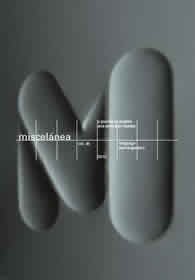Unification of the Semantics of the Infinitive in English
DOI:
https://doi.org/10.26754/ojs_misc/mj.20129255Keywords:
infinitive, gerund, possible worldsAbstract
This paper has two aims. The first aim is to unify the diverse interpretations of the to-infinitive in English. By adopting Lewis’s (1986) concept of possible worlds, I will claim that the infinitive represents incorporation of a possible world by the ‘real’ world. The second aim is to explain how certain predicates have come to select the infinitive or the gerund or both. I will argue that historic changes along with the semantic restraint of the infinitive can account for the current state of complementation.
Display downloads
References
Bladon, R.A.W. 1968. “Selecting the to- or –ing nominal after like, love, hate, dislike and prefer”. English Studies 49: 203-214.
Bolinger, Dwight. 1968. “Entailment and the meaning of structures”. Glossa 2(2): 119-127.
—. 1984. “Surprise”. In L. J. Raphael, C. B. Raphael, and M. R. Valdovinos (eds.) Language and cognition: Essays in honour of Arthur J. Bronstein. New York/London: Plenum Press: 45-58.
Close, Reginald Arthur. 1962. English as a foreign language. London: George Allen & Unwin.
De Smet, Hendrik. 2004. “Semantics and variation in complement constructions: Gerunds and infinitives following the verb like”. Belgian Journal of English Language and Literature. New Series 2: 247-260.
Dirven, René. 1989. “A cognitive perspective on complementation”. In Jaspers, D., W. Klooster, Y. Putseys, and P. Seuren (eds.) Sentential Complementation and the Lexicon. Dordrecht: Foris: 113-139.
Dixon, Robert M. W. 1984. “The semantic basis of syntactic properties”. Berkeley Linguistics Society 10: 583-595.
Duffley, Patrick J. 1992. The English infinitive. London: Longman.
—. 2000 “Gerund versus infinitive as complement of transitive verbs in English”. Journal of English Linguistics 28(3): 221-248.
Duffley, Patrick J. 2003. “The gerund and the to-infinitive as Subject”. Journal of English Linguistics 31(4): 324-352.
—. 2006. The English gerund-participle: A comparison with the infinitive. New York: Peter Lang Publishing.
Fanego, Teresa. 1996a. “The development of gerunds as objects of subject-control verbs in English (1400-1760)”. Diachronica 13: 29-62.
—. 1996b. “On the historical development of English retrospective verbs”. Neuphilologische Mitteilungen 97: 71-79
—. 2004. “Is Cognitive Grammar a Usage-Based Model? Towards a Realistic Account of English Sentential Complements”. Journal of English and American Studies 29: 23-58.
Fauconnier, Gilles. 1994. Mental spaces: Aspects of meaning construction in natural language. Cambridge, MA: MIT Press, 1985. Reprint, Cambridge: Cambridge University Press.
Hirtle, Walter H. 1975. Time, aspect and the verb. Québec: Presses de l’Université Laval.
Jespersen, Otto. 1940. Modern English grammar on historical principles. Part V. London: George Allen & Unwin.
Kempson, Ruth M. and Randolph Quirk. 1971. “Controlled activation of latent contrast”. Language 47: 548-572.
Kiparsky, Paul and Carol Kiparsky. 1970. “Fact”. In Bierwisch, M. and K.E. Heidolph (eds.) Progress in linguistics. The Hague: Mouton: 143-173.
Lewis, David. 1986. On the Plurality of Worlds, Oxford: Basil Blackwell.
Mair, Christian. 2003. “Gerundial complements after begin and start: Grammatical and sociolinguistic factors, and how they work against each other”. In Rohdenburg, G. and B. Mondorf (eds.) Determinants of Grammatical Variation in English. Berlin and New York: Mouton de Gruyter: 329-345.
Morita, Hisashi. 2011. “To-futeisi-no imi-ni tuite (About the meaning of to-infinitive)”. Mulberry 60: 33-50.
Quirk, Randolph, Sidney Greenbaum, Geoffrey Leech and Jan Svartvik. 1985. A comprehensive grammar of the English language. London: Longman.
Rudanko, Juhani. 1988. Change and Continuity in the English Language. Studies on Complementation over the Past Three Hundred Years. Lanham, New York and Oxford: University Press of America.
—. 1989. Complementation and Case Grammar: A Syntactic and Semantic Study of Selected Patterns of Complementation in Present-Day English. Albany: State University of New York Press.
Smith, Michael B. and Joyce Escobedo. 2001. “The semantics of to-infinitival vs. –ing verb complement constructions in English”. Chicago Linguistic Society 37: 549-563.
Stowell, Tim. 1982. “The tense of infinitives”. Linguistic Inquiry 13: 561-570.
Verspoor, Marjolijn. 1996. “The story of -ing: A subjective perspective”. In Pütz, M. and R Dirven (eds.) The Construal of Space in Language and Thought. Berlin and New York: Mouton de Gruyter: 417-454.
—. 1999. “To infinitives”. In L. Stadler and C. Eyrich (eds.). Issues in Cognitive Linguistics 12. Berlin: Mouton de Gruyter: 505-526.
Wierzbicka, Anna. 1988. The semantics of grammar. Amsterdam: John Benjamins.
Wood, Frederick T. 1956. “Gerund versus Infinitive”. English Language Teaching 11: 11-16.
Downloads
Published
Issue
Section
License
Copyright (c) 2013 Hisashi Morita

This work is licensed under a Creative Commons Attribution-NonCommercial 4.0 International License.


